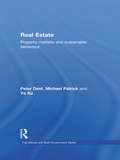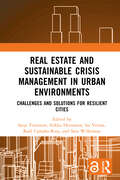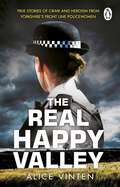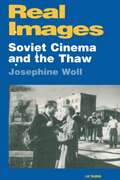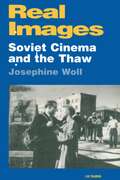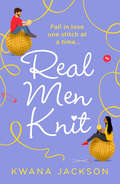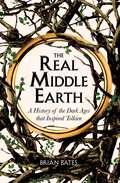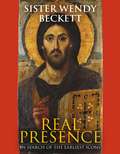- Table View
- List View
Reagan: American Icon
by Iwan MorganThe Reagan era is usually seen as an era of unheralded prosperity, and as a high-watermark of Republican success. President Ronald Reagan's belief in “Reaganomics”,his media-friendly sound-bites and “can do”personality have come to define the era.However, this was also a time of domestic protest and unrest. Under Reagan the USwas directly involved in the revolutions which were sweeping the Central Americas– El Salvador, Honduras and Guatemala –and in Nicaragua Reagan armed the Contras who fought the Sandinistas. This book seeks to show how the left withinthe US reacted and protested against these events. The Nation, Verso Books and the Guardian exploded in popularity, riding high on the back of popular anti-interventionist sentiment in America, whilethe film-maker Oliver Stone led a group ofdirectors making films with a radical left-wing message. The author shows how the1980s in America were a formative cultural period for the anti-Reaganites as well as the Reaganites, and in doing so charts a new history.
The Real Crown Jewels of England: 100 Places That Make Us Great
by Clive Aslet'Glorious' Daily Mail'Clive Aslet has been an extraordinarily informed and influential standard-bearer for the cause of the countryside and Britain's heritage for many years' Max HastingsOn 15 April 2019, Paris's beloved Notre Dame was ablaze. It shocked the world - a revered landmark, a national symbol, a manifestation of French identity was here today, gone tomorrow. Life is fragile. So are the buildings, monuments and landscapes that move us. The question 'what would you save if your house was on fire?' is a familiar parlour game. But what would you save if England was on fire? What are the places that we most cherish, that express qualities that are especially English? In this delightful celebration of the real crown jewels of England, Clive Aslet takes us on a journey of 100 places that make our country great. From ancient oaks and Devon lanes to war memorials and the BBC, the white cliffs of Dover to views of Durham from the train, Aslet lovingly captures the magic of the places that underpin our national identity.The Real Crown Jewels of England is both an invitation to rejoice in our common heritage, and to discover the world of astonishing beauty that lies just beyond your doorstep.
Real Deceptions: The Contemporary Reinvention of Realism
by Jennifer FriedlanderReal Deceptions develops a new theory of realism through close consideration of myriad contemporary art, media, and cultural practices. Rather than focusing on transgressing deceptions which distort reality, the book argues that reality lies within the deceptions themselves. That is to say, realism's political potential emerges not by revealing deception but precisely by staging deceptions--particularly deceptions that imperil the very categories of true and false. In lieu of perceiving deception as an obstacle to truth, it shows how deception functions as the truth's necessary conduit. Categories invoked in realist works, such as trompe l'oeil, illusion, hypervirtuality, and simulation help to establish how realism can be seen as moving from the creation of mere epistemological uncertainty to radical ontologically-based indeterminacy. The book cultivates this schema by considering productive connections between insights from Jacques Lacan and Jacques Rancière. Real Deceptions not only applies these theoretical frameworks to art and media examples, but also engages in the reverse move of using the "cases" to further the theories. This dual approach points to the ways in which efforts to produce realist representations often give rise to the destabilizing Real.
REAL DECEPTIONS C: The Contemporary Reinvention of Realism
by Jennifer FriedlanderReal Deceptions develops a new theory of realism through close consideration of myriad contemporary art, media, and cultural practices. Rather than focusing on transgressing deceptions which distort reality, the book argues that reality lies within the deceptions themselves. That is to say, realism's political potential emerges not by revealing deception but precisely by staging deceptions--particularly deceptions that imperil the very categories of true and false. In lieu of perceiving deception as an obstacle to truth, it shows how deception functions as the truth's necessary conduit. Categories invoked in realist works, such as trompe l'oeil, illusion, hypervirtuality, and simulation help to establish how realism can be seen as moving from the creation of mere epistemological uncertainty to radical ontologically-based indeterminacy. The book cultivates this schema by considering productive connections between insights from Jacques Lacan and Jacques Rancière. Real Deceptions not only applies these theoretical frameworks to art and media examples, but also engages in the reverse move of using the "cases" to further the theories. This dual approach points to the ways in which efforts to produce realist representations often give rise to the destabilizing Real.
Real Estate: Property Markets and Sustainable Behaviour
by Peter Dent Michael Patrick Xu YeTraditional studies of the property market have tended to focus solely on commercial and legal issues, but the growing importance of the issue of sustainability means that a different approach is needed. This new textbook provides an overview of property within a market context, examining the complex nature of property rights and issues related to both investors and occupiers. At the same time it assesses property from the perspective of financial, social and environment sustainability. Topics covered range from the characteristics of property and depreciation, to ownership and development through to investments and sustainability reporting. The book concludes with key skills in sustainable knowledge needed by those working in the real estate industry. Written by an author team of experienced property professionals, this essential introductory textbook is well suited for property, planning and architecture students on undergraduate, graduate and conversion courses, as well as those on CPD and training programmes in related areas.
Real Estate: Property Markets and Sustainable Behaviour
by Peter Dent Michael Patrick Xu YeTraditional studies of the property market have tended to focus solely on commercial and legal issues, but the growing importance of the issue of sustainability means that a different approach is needed. This new textbook provides an overview of property within a market context, examining the complex nature of property rights and issues related to both investors and occupiers. At the same time it assesses property from the perspective of financial, social and environment sustainability. Topics covered range from the characteristics of property and depreciation, to ownership and development through to investments and sustainability reporting. The book concludes with key skills in sustainable knowledge needed by those working in the real estate industry. Written by an author team of experienced property professionals, this essential introductory textbook is well suited for property, planning and architecture students on undergraduate, graduate and conversion courses, as well as those on CPD and training programmes in related areas.
Real Estate and Sustainable Crisis Management in Urban Environments: Challenges and solutions for resilient cities
by Sara Wilkinson Saija Toivonen Sirkka Heinonen Ira Verma Raúl Castaño-RosaThe aim of this book is to promote the dynamic resilience of societies by identifying, analysing, and exemplifying the role of space and land use in both anticipated and unanticipated primary and secondary crisis situations. The book brings together the expertise of a unique team of researchers and methods from fields of futures studies, land use planning, social sustainability and wellbeing, architecture, spatial planning, design and real estate economics, and presents a novel understanding of the direct and indirect impacts of possible crises in the space and land use context. It goes on to discuss the concept of resilience and exemplifies potential solutions and offers a holistic and forward-looking approach for crisis management through a lens of social sustainability and wellbeing, making an important contribution to the promotion of wellbeing in the built environment, especially in terms of land and residential space and building use. This book does not only identify barriers and successful incentives in resilient crisis management but also discusses the role of different stakeholders (e.g., households, office workers, real estate owners, space occupants, firms, the public sector, etc.) in crisis management. Finally, international case studies aiming to tackle the challenging landscape of future threats are presented, along with novel tools to support the development of future policies, regulations, and management practices in the built environment, which can increase the dynamic resilience of societies. Overall, this book is essential reading for decision-makers in the public and private sectors, urban developers, space and spatial designers, architects, planners, community stakeholders, real estate investors, facility managers and crisis and corporate responsibility managers.
Real Estate and Sustainable Crisis Management in Urban Environments: Challenges and solutions for resilient cities
by Sara Wilkinson Saija Toivonen Sirkka Heinonen Ira Verma Raúl Castaño-RosaThe aim of this book is to promote the dynamic resilience of societies by identifying, analysing, and exemplifying the role of space and land use in both anticipated and unanticipated primary and secondary crisis situations. The book brings together the expertise of a unique team of researchers and methods from fields of futures studies, land use planning, social sustainability and wellbeing, architecture, spatial planning, design and real estate economics, and presents a novel understanding of the direct and indirect impacts of possible crises in the space and land use context. It goes on to discuss the concept of resilience and exemplifies potential solutions and offers a holistic and forward-looking approach for crisis management through a lens of social sustainability and wellbeing, making an important contribution to the promotion of wellbeing in the built environment, especially in terms of land and residential space and building use. This book does not only identify barriers and successful incentives in resilient crisis management but also discusses the role of different stakeholders (e.g., households, office workers, real estate owners, space occupants, firms, the public sector, etc.) in crisis management. Finally, international case studies aiming to tackle the challenging landscape of future threats are presented, along with novel tools to support the development of future policies, regulations, and management practices in the built environment, which can increase the dynamic resilience of societies. Overall, this book is essential reading for decision-makers in the public and private sectors, urban developers, space and spatial designers, architects, planners, community stakeholders, real estate investors, facility managers and crisis and corporate responsibility managers.
Real Estate Development Matrix
by Daniel B Kohlhepp Kimberly J. KohlheppThis book presents a new way of thinking about, teaching, learning, and practicing real estate development. Real Estate Development Matrix describes the process in a two-dimensional model and presents seven Development Stages which form the horizontal axis, and eight sets of Development Tasks which form the vertical axis to define a 56-cell matrix. In each cell, money is spent and risks are taken to achieve certain tasks and thereby create (or destroy) value. This holistic process considers the entire life cycle of real estate from its "green field" inception to its "brown field" state. The book is written by a real estate developer and academic, and the presented material is conceptual, practical, and non-technical. Jargon has been minimized as much as possible as the author introduces an entirely new model for real estate development that is both academically authoritative and developed in practice. It is aimed at a general professional audience participating in the development process, but equally the book is ideal for use as a textbook in undergraduate and graduate courses in real estate development, and an excellent supplemental text for business courses discussing real estate finance and investment. It may also be used as a textbook for professional courses, workshops, or seminars in real estate development. The book is supported by an interactive website at http://realestatedevelopmentmatrix.com/
Real Estate Development Matrix: A Handbook
by Daniel B Kohlhepp Kimberly J. KohlheppThis book presents a new way of thinking about, teaching, learning, and practicing real estate development. Real Estate Development Matrix describes the process in a two-dimensional model and presents seven Development Stages which form the horizontal axis, and eight sets of Development Tasks which form the vertical axis to define a 56-cell matrix. In each cell, money is spent and risks are taken to achieve certain tasks and thereby create (or destroy) value. This holistic process considers the entire life cycle of real estate from its "green field" inception to its "brown field" state. The book is written by a real estate developer and academic, and the presented material is conceptual, practical, and non-technical. Jargon has been minimized as much as possible as the author introduces an entirely new model for real estate development that is both academically authoritative and developed in practice. It is aimed at a general professional audience participating in the development process, but equally the book is ideal for use as a textbook in undergraduate and graduate courses in real estate development, and an excellent supplemental text for business courses discussing real estate finance and investment. It may also be used as a textbook for professional courses, workshops, or seminars in real estate development. The book is supported by an interactive website at http://realestatedevelopmentmatrix.com/
Real Estate in Central America, Mexico and the Caribbean (Routledge International Real Estate Markets Series)
by Claudia Murray Camilla Ween Yadira Torres-Romero Yazmin RamirezThis book examines real estate markets and urban development in Central America, Mexico and The Caribbean (CAMEC). It considers both residential and commercial real estate with a focus on industrial and hospitality sectors, infrastructure and logistics. The CAMEC region is besieged by complexity. Prone to natural disasters, and with the Mexico/US border constituting the largest human migration corridor on Earth, the region is also a vital trading hub for goods, linking commerce between the world’s two largest oceans and the Americas. The real estate markets in this area are dynamic, rapidly developing and under researched. This book analyses the particularities of these markets and the context in which investors and developers operate. The authors present case studies and contributions from key players in major cities in the region. The book exposes the regional risks and opportunities connected to urban development including market transparency, urban equity and development regulation. The research presented in this volume gives the reader a comprehensive picture of each country under study, detailing their individual commercial, residential, industrial, leisure and infrastructure sectors. This is essential reading for international investors, real estate students, researchers, and professionals with an interest in the region.
Real Estate in Central America, Mexico and the Caribbean (Routledge International Real Estate Markets Series)
by Claudia Murray Camilla Ween Yadira Torres-Romero Yazmin RamirezThis book examines real estate markets and urban development in Central America, Mexico and The Caribbean (CAMEC). It considers both residential and commercial real estate with a focus on industrial and hospitality sectors, infrastructure and logistics. The CAMEC region is besieged by complexity. Prone to natural disasters, and with the Mexico/US border constituting the largest human migration corridor on Earth, the region is also a vital trading hub for goods, linking commerce between the world’s two largest oceans and the Americas. The real estate markets in this area are dynamic, rapidly developing and under researched. This book analyses the particularities of these markets and the context in which investors and developers operate. The authors present case studies and contributions from key players in major cities in the region. The book exposes the regional risks and opportunities connected to urban development including market transparency, urban equity and development regulation. The research presented in this volume gives the reader a comprehensive picture of each country under study, detailing their individual commercial, residential, industrial, leisure and infrastructure sectors. This is essential reading for international investors, real estate students, researchers, and professionals with an interest in the region.
The Real Happy Valley: True stories of crime and heroism from Yorkshire’s front line policewomen
by Alice VintenA collection of real-life cases showing the bravery of female police officers.Former Police Constable Alice Vinten shares the stories of brave policewomen who spent their entire careers at the sharp end of crime-fighting.The Real Happy Valley reveals what life on the beat is really like. From dealing with domestic abuse cases to facing personal assaults, gang crime and murder, these courageous women stop at nothing to bring criminals to justice, never failing to put others' safety before their own.Gripping and inspiring, The Real Happy Valley is a celebration of our finest policewomen's extraordinary courage, and their peerless commitment to protect and serve.
Real Images: Soviet Cinema and the Thaw (KINO - The Russian and Soviet Cinema)
by Josephine WollDuring ""the thaw"" from Stalin's death in 1953 to the late 1960s and Khrushchev's rule, Soviet society experienced major transformations. So did films. In this first comprehensive account of the relationship between politics and cinema in this period, Josephine Woll skillfully interweaves cultural history with film analysis to explore how movies at once responded to the changes around them and helped engender them. She considers dozens of individual films within the context of Khrushchev's policies and the artistic foment they inspired.
Real Images: Soviet Cinema and the Thaw (KINO - The Russian and Soviet Cinema)
by Josephine WollDuring ""the thaw"" from Stalin's death in 1953 to the late 1960s and Khrushchev's rule, Soviet society experienced major transformations. So did films. In this first comprehensive account of the relationship between politics and cinema in this period, Josephine Woll skillfully interweaves cultural history with film analysis to explore how movies at once responded to the changes around them and helped engender them. She considers dozens of individual films within the context of Khrushchev's policies and the artistic foment they inspired.
Real Men Knit
by Kwana Jackson‘A SWOONFEST’ Lindsey Kelk Don’t miss this a charming and feel-good own-voices romance – funny, sexy and as cosy as a woolly jumper…
The Real Middle-Earth
by Brian BatesIn The Real Middle-Earth, explore the magically enchanting early-English civilization on which Tolkien based his world of The Lord of the Rings.Tolkien readily admitted that the concept of Middle-earth was not his own invention. An Old English term for the Dark Age world, it was always assumed that the importance of magic in this world existed only in Tolkien’s works; now Professor Brian Bates reveals the vivid truth about this historical culture. Behind the stories we know of Dark Age kings and queens, warriors and battles, lies the hidden history of Middle-earth, a world of magic, mystery and destiny. Fiery dragons were seen to fly across the sky, monsters haunted the marshes, and elves fired poisoned arrows. Wizards cast healing spells, wise trees gave blessings, and omens foretold the deaths of kings. The very landscape itself was enchanted and the world imbued with a life force.Repressed by a millennium of Christianity, this belief system all but disappeared, leaving only faint traces in folk memory and fairy tales. In this remarkable book Professor Brian Bates has drawn on the latest archaeological findings to reconstruct the imaginative world of our past, revealing a culture with insights that may yet help us understand our own place in the world.
A Real Part to Play: A resource pack for involving young people in community regeneration (PDF)
by Elin Stefansson Ruth Dalzell Dalzell Ruth DalzellA Real Part to Play follows the evolutionary stages of project development, from planning children and young people's involvement to working with them and evaluating the results of a specific project. It considers the context of involving children and young people in community regeneration and possible problems. It includes examples of good practice, practical tips, checklists, advice and activities. If you are a professional working in community regeneration, or simply want to increase children and young people's involvement in your community, this manual provides inspiration and a starting point for discussion. The material can be modified and developed to make it useful for your community.
Real Presence: In Search of the Earliest Icons
by Sister Wendy BeckettIn Encounters with God Sister Wendy Beckett travelled to remote churches and monasteries to view the earliest icons of Mary. In Real Presence she resumes this journey to see additional early icons of Jesus and the saints - icons that are among the few to survive the wholesale destruction of icons in the early eighth century. In contrast to the familiar and magnificent icons of later history, these early icons have a haunting simplicity and unfamiliar spiritual power. They come to us from a time closer to that of Christ, when faith was still alive with wonder and possibilities, and these images, a vehicle for prayer, can truly convey his real presence. Prayerful and heartfelt, Real Presence engages with the spiritual imagination of the early church, giving insight into all the emotion and drama of early Christianity and, in so doing, deepens our understanding of faith lived out today.
Real Property in Australia: Foundations and Applications
by Michael J. HefferanReal property in the form of investment, ownership and use pervades almost every aspect of daily lives and represents over 40% of Australia’s wealth. Such assets do not exist in isolation – they are dynamic and forever evolving, impacted by a range of physical, economic, demographic, legal and other forces. Consequently, a true appreciation of individual assets and of the property sector as a whole demands an understanding of both the assets themselves and the context and markets in which they exist. The sector is complex and, on the face of it, confusing. It is however, not without logic and underlying themes and principles. This book provides a wider understanding of how the real property sector works. It covers topics such as the nature of real property and its functions, economic drivers, valuation principles, legal and tenure parameters, property taxation, land development and subdivision, asset and property management and sustainability – all critical components in this complex and critically important sector. It provides a wide and balanced perspective for experienced practitioners, investors, students and anyone involved in property decision-making or wishing to secure a deeper understanding of these areas. The book integrates research-based theory with practical application and first-hand insights into a sector that underpins the Australian economy, its communities and its sustainability.
Real Property in Australia: Foundations and Applications
by Michael J. HefferanReal property in the form of investment, ownership and use pervades almost every aspect of daily lives and represents over 40% of Australia’s wealth. Such assets do not exist in isolation – they are dynamic and forever evolving, impacted by a range of physical, economic, demographic, legal and other forces. Consequently, a true appreciation of individual assets and of the property sector as a whole demands an understanding of both the assets themselves and the context and markets in which they exist. The sector is complex and, on the face of it, confusing. It is however, not without logic and underlying themes and principles. This book provides a wider understanding of how the real property sector works. It covers topics such as the nature of real property and its functions, economic drivers, valuation principles, legal and tenure parameters, property taxation, land development and subdivision, asset and property management and sustainability – all critical components in this complex and critically important sector. It provides a wide and balanced perspective for experienced practitioners, investors, students and anyone involved in property decision-making or wishing to secure a deeper understanding of these areas. The book integrates research-based theory with practical application and first-hand insights into a sector that underpins the Australian economy, its communities and its sustainability.
The Real Real Thing: The Model in the Mirror of Art
by Wendy SteinerOur era is defined by the model. From Victoria’s Secret and America’s Next Top Model to the snapshots we post on Facebook and Twitter, our culture is fixated on the pose, the state of existing simultaneously as artifice and the real thing. In this bold view of contemporary culture, Wendy Steiner shows us the very meaning of the arts in the process of transformation. Her story begins at the turn of the last century, as the arts abandoned the representation of the world for a heady embrace of the abstract, the surreal, and the self-referential. Today though, this “separate sphere of the aesthetic” is indistinguishable from normal life. Media and images overwhelm us: we gingerly negotiate a real-virtual divide that we suspect no longer exists, craving contact with what J. M. Coetzee has called “the real real thing.” As the World Wide Web renders the lower-case world in ever-higher definition, the reality-based genres of memoir and documentary are displacing fiction, and novels and films are depicting the contemporary condition through model-protagonists who are half-human, half-image. Steiner shows the arts searching out a new ethical potential through this figure: by stressing the independent existence of the model, they welcome in the audience in all its unpredictability, redefining aesthetic experience as a real-world interaction with the promise of empathy, reciprocity, and egalitarian connection. A masterly performance by a penetrating, inquisitive mind, The Real Real Thing is that rarest of books, one whose provocations and inspirations will inspire readers to take a new—and nuanced—look at the world around them.
Real Sex Films: The New Intimacy and Risk in Cinema
by John Tulloch Belinda MiddleweekReal Sex Films explores one of the most controversial movements in international cinema through an innovative interdisciplinary combination of theories of globalization and embodiment. Risk sociology, feminist film theory, and critical feminist mapping theory are brought together with concepts of production, narrative, genre, authorship, stardom, spectatorship, and social audience as several lenses of understanding and extension in ways of seeing real-sex cinema. Notions of personal subjectivity and critical distance, disciplinary co-operation and critique, and cinematic perceptions of the utopia and dystopia of love within risk modernity are the tensions exposed reflexively and in parallel, as each chapter focuses different lenses communicating intimacy, desire, risk and transgression. This book substantively, methodologically, and theoretically embraces and engages in its consideration of the images, ethics, double standards, and embodiments of brutal cinema. Crossing the boundaries of film studies, media and cultural studies, the ethnographic turn, risk sociology, feminist psychoanalytical, and geopolitical studies, this is a book for students, academics, as well as general and professional audiences.
REAL SEX FILMS C: The New Intimacy and Risk in Cinema
by John Tulloch Belinda MiddleweekReal Sex Films explores one of the most controversial movements in international cinema through an innovative interdisciplinary combination of theories of globalization and embodiment. Risk sociology, feminist film theory, and critical feminist mapping theory are brought together with concepts of production, narrative, genre, authorship, stardom, spectatorship, and social audience as several lenses of understanding and extension in ways of seeing real-sex cinema. Notions of personal subjectivity and critical distance, disciplinary co-operation and critique, and cinematic perceptions of the utopia and dystopia of love within risk modernity are the tensions exposed reflexively and in parallel, as each chapter focuses different lenses communicating intimacy, desire, risk and transgression. This book substantively, methodologically, and theoretically embraces and engages in its consideration of the images, ethics, double standards, and embodiments of brutal cinema. Crossing the boundaries of film studies, media and cultural studies, the ethnographic turn, risk sociology, feminist psychoanalytical, and geopolitical studies, this is a book for students, academics, as well as general and professional audiences.
The Real Thing: The Real Thing; Night And Day; Hapgood; Indian Ink; Arcadia
by Tom StoppardThe play begins with Max and Charlotte, a couple whose marriage seems about to rupture. But nothing one sees on a stage is the real thing, and some things are less real than others. Charlotte is an actress who has been appearing in a play about marriage written by her husband Henry. Max, her leading man, is also married to an actress, Annie. Both marriages are at the point of rupture because Henry and Annie have fallen in love. But is it the real thing?



